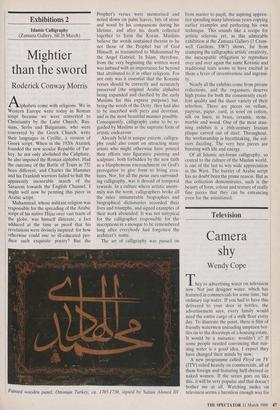Exhibitions 2
Islamic Calligraphy (Zamana Gallery, till 26 March)
Mightier than the sword
Roderick Conway Morris
Alphabets come with religions. We in Western Europe write today in Roman script because we were converted to Christianity by the Latin Church; Rus- sians, Serbs and Bulgarians, who were converted by the Greek Church, write their languages in Cyrillic, a version of Greek script. When in the 1920s Atatiirk founded the new secular Republic of Tur- key, he not only abolished the Caliphate, he also imposed the Roman alphabet. Had the outcome of the Battle of Tours in 732 been different, and Charles the Hammer and his Frankish warriors failed to halt the apparently inexorable march of the Saracens towards the English Channel, I might well now be penning this piece in Arabic script.
Muhammad, whose militant religion was responsible for the spreading of the Arabic script of his native Hijaz over vast tracts of the globe, was himself illiterate, a fact adduced at the time as proof that his revelations were divinely inspired: for how Otherwise could one so ill-educated pro- duce such exquisite poetry? But the Prophet's verses were memorised and noted down on palm leaves, bits of stone and wood by his companions during his lifetime, and after his death collected together to form the Koran. Muslims believe the words contained therein to be not those of the Prophet but of God Himself, as transmitted to Muhammad by the Angel Gabriel. In Islam, therefore, from the very beginning the written word was imbued with an importance far beyond that attributed to it in other religions. For not only was it essential that the Koranic verses should be correctly and accurately preserved (the original Arabic alphabet being expanded and clarified by the early Muslims for this express purpose) but, being the words of the Deity, they had also to be inscribed with piety and devotion, and in the most beautiful manner possible. Consequently, calligraphy came to be re- garded by Muslims as the supreme form of artistic endeavour.
Already held in unique esteem, calligra- phy could also count on attracting many artists who might otherwise have poured their efforts into figurative painting and sculpture, both forbidden by the new faith as a blasphemous encroachment on God's prerogative to give form to living crea- tures. Nor, for all the pious aura surround- ing calligraphy, was it devoid of temporal rewards. In a culture where artistic anony- mity was the norm, calligraphers broke all the rules: innumerable biographies and biographical dictionaries recorded their lives and triumphs, and signed examples of their work abounded. It was not untypical for the calligrapher responsible for the. inscriptions in a mosque to be remembered long after everybody had forgotten the architect's name.
The art of calligraphy was passed on Painted wooden panel, Ottoman Turkey, ca. 1703-1730, signed by Sultan Ahmed III from master to pupil, the aspiring appren- tice spending many laborious years copying earlier examples and perfecting his own technique. This sounds like a recipe for artistic sclerosis yet, as this admirable exhibition at the Zamana Gallery (1 Crom- well Gardens, SW7) shows, far from cramping the calligraphic artists' creativity, the inescapable obligation to reproduce over and over again the same Koranic and traditional texts seems to have excited in them a fever of inventiveness and ingenui- ty.
Nearly all the exhibits come from private collections, and the organisers deserve high praise for both the consistently excel- lent quality and the sheer variety of their selection. There are pieces on vellum, papyrus, paper, card, in wool on cotton, silk on linen, in brass, ceramic, stone, marble and wood. One of the most stun- ning exhibits is a 16th-century Iranian plaque carved out of steel. Throughout, the workmanship is breathtaking, the col- ours dazzling. The very best pieces are bursting with life and energy.
Of all Islamic art-forms calligraphy, so central to the culture of the Muslim world, is one of the last to win wide appreciation in the West. The barrier of Arabic script has no doubt been the prime reason. But as this collection demonstrates, such is the beauty of form, colour and texture of really fine pieces that they can be entrancing even for the uninitiated.


























































 Previous page
Previous page